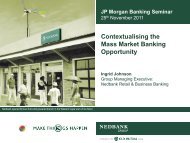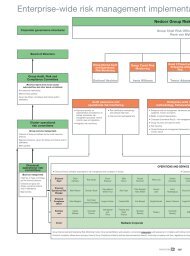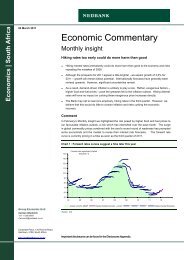OVERVIEWBackgroundIn 2009 the local banking industry continued to experience atough and volatile year as a result of the impact of the ongoingglobal recession, combined with cyclical credit stresses in thedomestic economy. In response to the global financial crisis,during 2009 <strong>Nedbank</strong> continued its focus on proactive riskmanagement and strengthening of capital ratios as well as furtherdiversifying the funding base, lengthening the funding profile andincreasing liquidity buffers. Although underlying conditions in thebanking industry are expected to remain challenging for 2010, theSA economy is expected to grow by around 2,2%, which shouldtranslate into a better year for banking.The landscape of banking is changing rapidly following theglobal financial crisis and the significant international regulatoryresponse that is underway. Much of this change relates toand impacts the measurement and management of risk, thebalance sheet (in particular, capital and liquidity) and financialperformance, as well as the associated remuneration practices ofbanks.South Africa’s banking industry has remained structurally soundand weathered the global financial crisis and local recessionextremely well due to factors that include:• Sound and proactive regulation of financial services, especiallyin the banking sector.• Strong risk and capital management in the SA bankingindustry.• Basel II being successfully implemented and embraced inSouth Africa.• The National Credit Act being successfully implemented inSouth Africa to help minimise irresponsible lending practices,overgearing and excessive consumer debt.• Fiscal authorities in South Africa never allowing interest ratesto fall as low and for as long as in the United States, wherethis resulted in excessive borrowing and untenable levels ofhousehold debt. South Africa has not had negative realinterest rates.• Exchange controls preventing large flows of funds from localinstitutions out of the country.• Rand liquidity remaining stable, with the interbank marketoperating normally.• The ‘originate and sell’ business model and complex creditderivatives, which resulted in excessive leverage in someforeign banks, not being implemented and used in South Africato the same extent.• Lessons learned from the 2002/3 SA banking crisis.In South Africa our banking regulator has consistently beeneffective, and this has played a significant role in preventing anylocal fallout from the global financial crisis. However, South Africadoes operate in a globally regulated market and the significantresponse to the crisis by international regulators, in particular theBasel Committee on Banking Supervision (Basel Committee), willhave an effect on the local banking industry.<strong>Nedbank</strong> <strong>Group</strong> anticipates that the impact on the group ofthe proposed international regulatory changes will be moderaterather than pervasive, with one potential exception (see below).This view is substantiated by the sound positioning of theSA banking industry throughout the global financial crisis,successful Basel II implementation in 2008 and, in particular,<strong>Nedbank</strong> <strong>Group</strong>’s prudent risk appetite, sound governanceand strong risk culture, which is evidence of <strong>Nedbank</strong> <strong>Group</strong>’s‘business benefits’-based approach to the implementation ofBasel II, where our emphasis was not only to comply withBasel II, but also to elevate the group’s risk, capital and balancesheet management to best-practice standards.The possible exception to the moderate impact discussed abovewill be the new international regulatory liquidity proposals forwhich the impact would be pervasive if implemented as theystand, but we anticipate modifications and changes appropriatefor South Africa and its various structural issues. SA banks arewell-funded and liquid, and remained so throughout the globalfinancial crisis mainly due to the sound, small and closed natureof the local funding system.The new <strong>Group</strong> Executive Committee structure, which wascompleted in January 2010, also includes the creation of aspecialist Balance Sheet Management cluster. This recognisesthe importance of managing risk on a portfolio basis andintegrating the management of risk with liquidity and funding,capital management, shareholder value-add optimisationand reward practices. The creation of this new cluster is alsoacknowledgement that portfolio optimisation is an essentialcomponent of optimising the financial returns and long-termsustainability of the group.Regulation 43 of the regulations relating to banks in SouthAfrica requires disclosure to the public of reliable, relevant andtimely qualitative and quantitative information that enablesusers of that information, among other things, to make anaccurate assessment of a bank’s financial condition, including itscapital adequacy, financial performance, business activities, riskprofile and risk management practices. <strong>Nedbank</strong> <strong>Group</strong> is fullycommitted to regulation 43.The requirements of regulation 43 are aligned with InternationalFinancial Reporting Standards but significantly extend the publicdisclosure requirements. This extension of disclosure is embodiedin what is commonly known as ‘Pillar 3’ of the Basel II Accord.A copy of the unabridged Pillar 3 Report may be found on thegroup’s website at www.nedbankgroup.co.za.127<strong>NEDBANK</strong> GROUP ANNUAL REPORT 2009GROUP REPORTSOPERATIONAL REVIEWSGOVERNANCE
isk and BALANCE SHEET management reportGlobal regulatory developments and thechanging landscape of bankingThe measures taken by the Basel Committee in July 2009 tostrengthen the international Basel II framework, as well as thefar-reaching proposals released in December 2009, are thecommittee’s comprehensive response, under the mandate ofthe group of 20 leading economies, to address the lessons of theglobal financial crisis.The Basel Committee’s proposals aim to strengthen global capitaland liquidity regulations with the goal of promoting a moreresilient banking sector. The objective of the reform package is toimprove the banking sector’s ability to absorb shocks arising fromfinancial and economic stress, whatever the source, thus reducingthe risk of spillover from the financial sector to the real economy.Through its reform package the Basel Committee also aims toimprove risk management and governance as well as strengthenbanks’ transparency and disclosures. Moreover, the reformpackage also includes the committee’s efforts to strengthen theresolution of systemically significant crossborder banks and thefinancial regulatory system.The new Basel requirements and proposals are discussed in moredetail below.The first response package was released in July 2009 andincluded improvements to Basel II’s Pillars 1, 2 and 3.• Enhancements to Pillar 1− Securitisation (implementation end 2009).− Market trading risk (implementation end 2010).• Enhancements to Pillar 2 Internal Capital Adequacy AssessmentProcess (ICAAP) (implementation July 2009)− Bankwide governance and risk management.− Principles for sound liquidity risk management.− Principles for risk concentrations.− Sound remuneration practices (risk-based).− Valuation and liquidity risks of financial instrument fair-valuepractices.− Principles for sound stress-testing practices.− Off-balance-sheet exposures and securitisation activities.− Reputational risk and implicit support.• Enhancements to Pillar 3 (public disclosure/market discipline)− Securitisation exposures (implementation end 2009).The second response package, which includes only proposals atthis stage, was released in December 2009. The objectives of theproposals in this package are as follows:• Raising the quality, consistency and transparency of the capitalbase, while also harmonising the other elements of a bank’scapital structure.• Strengthening risk coverage.In addition to the trading book and securitisation reformsannounced in July 2009, the new proposals includestrengthening of the capital requirements for counterpartycredit risk exposures arising from derivatives, repurchaseagreements (repos) and securities financing activities. Thestrengthened counterparty credit risk capital requirements willalso increase incentives to move over-the-counter derivativeexposures to central counterparties and exchanges, andgenerally improve counterparty credit risk management. Theinterconnectivity of large financial institutions is also a keyfocus area as reflected by, for example, introducing a multiplier(1,25) to the asset value correlation for these exposures heldby banks.• Introducing a leverage ratio as a supplementary measure to theBasel II risk-based framework.The leverage ratio will help contain the buildup of excessiveleverage in the banking system. To ensure comparability thedetails of the leverage ratio will be harmonised internationally,fully adjusting for any remaining differences in accounting.• Reducing procyclicality and promoting countercyclical capitalbuffers.The key objectives are:− Dampen any excess cyclicality of the minimum capitalrequirement.− Promote more forward-looking credit provisions basedon ‘expected losses’, rather than the current ‘incurredloss’ provisioning model under the International FinancialReporting Standards.− Conserve capital to build buffers that can be used in stressby the introduction of a framework linking the amount ofearnings a bank is allowed to distribute to shareholders tothe bank’s capital ratios.− Protect the banking sector from periods of excess creditgrowth by requiring banks further to increase capital buffersavailable when selected macroeconomic indicators suggestthat credit volumes have grown excessively.• Introducing a global liquidity framework.This would consist of a stressed liquidity coverage ratio, alonger-term structural stable funding ratio and a common setof monitoring metrics to assist in identifying and analysingliquidity risk trends. These complement the Basel Committee’s‘Principles for sound liquidity risk management and supervision’issued in September 2008.128<strong>NEDBANK</strong> GROUP ANNUAL REPORT 2009

















